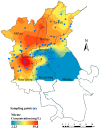Health Risk Assessment of Nitrate in Drinking Water with Potential Source Identification: A Case Study in Almaty, Kazakhstan
- PMID: 38248520
- PMCID: PMC10815420
- DOI: 10.3390/ijerph21010055
Health Risk Assessment of Nitrate in Drinking Water with Potential Source Identification: A Case Study in Almaty, Kazakhstan
Abstract
Infant mortality in Kazakhstan is six times higher compared with the EU. There are several reasons for this, but a partial reason might be that less than 30% of Kazakhstan's population has access to safe water and sanitation and more than 57% uses polluted groundwater from wells that do not comply with international standards. For example, nitrate pollution in surface and groundwater continues to increase due to intensified agriculture and the discharge of untreated wastewater, causing concerns regarding environmental and human health. For this reason, drinking water samples were collected from the water supply distribution network in eight districts of Almaty, Kazakhstan, and water quality constituents, including nitrate, were analyzed. In several districts, the nitrate concentration was above the WHO and Kazakhstan's maximum permissible limits for drinking water. The spatial distribution of high nitrate concentration in drinking water was shown to be strongly correlated with areas that are supplied with groundwater, whereas areas with lower nitrate levels are supplied with surface water sources. Based on source identification, it was shown that groundwater is likely polluted by mainly domestic wastewater. The health risk for infants, children, teenagers, and adults was assessed based on chronic daily intake, and the hazard quotient (HQ) of nitrate intake from drinking water was determined. The non-carcinogenic risks increased in the following manner: adult < teenager < child < infant. For infants and children, the HQ was greater than the acceptable level and higher than that of other age groups, thus pointing to infants and children as the most vulnerable age group due to drinking water intake in the study area. Different water management options are suggested to improve the health situation of the population now drinking nitrate-polluted groundwater.
Keywords: SDGs; drinking water; groundwater; health risk; infant health; nitrate pollution.
Conflict of interest statement
Author Lars Carlsen owns the company Awareness Center. The remaining authors declare that the research was conducted in the absence of any commercial or financial relationships that could be construed as a potential conflict of interest.
Figures



References
-
- United Nations . Environmental Performance Reviews—Kazakhstan: Third Review; Synopsis. United Nations; Geneva, Switzerland: 2019. [(accessed on 20 June 2023)]. Available online: https://unece.org/DAM/env/epr/epr_studies/Synopsis/ECE.CEP.185_ENG_Synop....
-
- Issanova G., Jilili R., Abuduwaili J., Kaldybayev A., Saparov G., Yongxiao G. Water availability and state of water resources within water-economic basins in Kazakhstan. Paddy Water Environ. 2018;16:183–191. doi: 10.1007/s10333-018-0630-6. - DOI
-
- Sachs J., Lafortune G., Kroll C., Fuller G., Woelm F. Sustainable Development Report 2022. Cambridge University Press; Cambridge, UK: 2022. - DOI
-
- United Nations Development Program Access to Drinking Water and Sanitation in the Republic of Kazakhstan. 2016. [(accessed on 22 June 2023)]. Available online: http://www.caresd.net/iwrm/new/en/doc/report_eng.pdf.
Publication types
MeSH terms
Substances
Grants and funding
LinkOut - more resources
Full Text Sources
Medical

